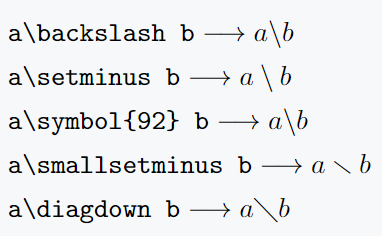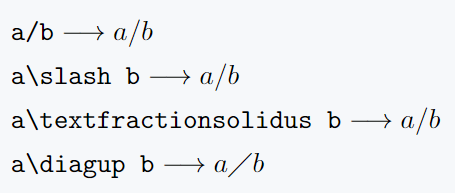When working with LaTeX, we often need to use special characters like \ (backslash) and / (forward slash). These symbols play an essential role in formatting and structuring documents.
This symbol is particularly important because it is used to define LaTeX commands. Since it has a functional purpose, it cannot be printed directly in the output.
On the other hand, the forward slash can be displayed normally, but in certain cases, it may cause formatting issues.
In this tutorial, we will explore different ways to print them properly without affecting the document’s structure.
Backslash (\)
Since the backslash is used for LaTeX commands, it cannot be printed directly.
To display it in a document, various commands are available, some for-text mode and others for math mode.
Using in Text Mode
In LaTeX, the \textbackslash command is used to display this character in text mode.
Another option is \symbol{92}, which requires the \usepackage[T1]{fontenc} package. This method works in both text and math modes.
\documentclass{article}
\usepackage{amssymb} % for \longrightarrow
\usepackage[T1]{fontenc} % for \symbol{92}
\begin{document}
\verb|a\symbol{92} b|\longrightarrow a\symbol{92}b \\[4pt]
\verb|a\textbackslash b|\longrightarrow a\textbackslash b
\end{document}Output:
Using in Math Mode
In math mode, the \setminus command can be used to display this character.
Additionally, the amssymb package provides \smallsetminus and \diagdown for similar purposes. The table below shows these commands with their outputs.
\documentclass{article}
\usepackage{amssymb} % for \longrightarrow
\usepackage[T1]{fontenc} % for \symbol{92}, \smallsetminus, \diagdown
\begin{document}
\[ \verb|a\backslash b|\longrightarrow a\backslash b \]
\[ \verb|a\setminus b|\longrightarrow a\setminus b \]
\[ \verb|a\symbol{92} b|\longrightarrow a\symbol{92}b \]
\[ \verb|a\smallsetminus b|\longrightarrow a\smallsetminus b \]
\[ \verb|a\diagdown b|\longrightarrow a\diagdown b \]
\end{document}Output :
LaTeX provides the \verb|..| command, which prints text exactly as written without compiling it.
This is useful for displaying special characters or commands in a document, though the output font may appear slightly different.
Forward slash (/) in LaTeX
The / symbol can be printed directly, but using it within words, like village/city, prevents proper line breaks. If placed at the end of a line, the entire phrase moves to the next line instead of splitting naturally.
To avoid this, LaTeX provides the \slash command, which ensures proper word separation. This command works in both text and math modes without causing formatting issues.
\documentclass{article}
\begin{document}
You can achieve anything. It doesn't matter if you are from a small city/village. You can definitely do it.
\par
You can definitely do it. It doesn't matter if you are from a small city \slash village.
\end{document}Output :
The \textfractionsolidus command from the textcomp package works in both text and math modes, while the \diagup command from the amssymb package is limited to math mode.
\documentclass{article}
\usepackage{amssymb}
\usepackage{textcomp}
\begin{document}
\[ \verb|a/b|\longrightarrow a/b \]
\[ \verb|a\slash b|\longrightarrow a\slash b \]
\[ \verb|a\textfractionsolidus b|\longrightarrow a\textfractionsolidus b \]
\[ \verb|a\diagup b|\longrightarrow a\diagup b \]
\end{document}Output :



